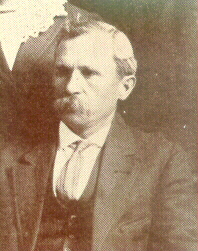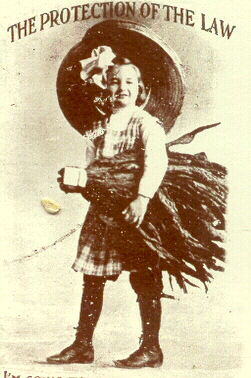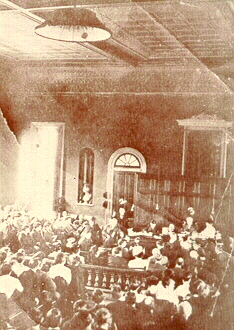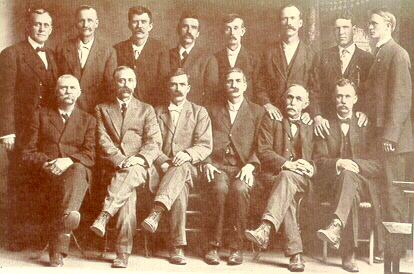NIGHT RIDERS
During the period between
1900 and 1906
trouble began to brew among the tobacco men of the
state, especially in
the Black Patch area around Hopkinsville. the buyers
had formed a trust
and were controlling the market. They were getting
tobacco at ridiculously
low prices and the farmers were unable to make a
living.
On September 24, 1904, Felix
Ewing and Joel
and Charles Fort addressed a gathering of
1,000 farmers in Guthrie
and formed an organization to fight the trust. They
secured a charter and
called themselves "The Planters Protective
Association". Within a few days
they had enlisted more than 5,000 new members. The
primary objective of
the Association was for the farmers to obtain better
prices for their crops
by pooling them and fixing their own prices.
A great many farmers refused to join the Association
and they were paid
higher prices by the Trust in an attempt to break up
the Association. There
was a great deal of friction between these two groups
of farmers.
"Night riding" began almost at once in an attempt to
force the outsiders
(or Hillbillies, as they were called) into the
Association. Independent
farmers were threatened by anonymous letters, barns
were burned and plant
beds were scraped. Bundles of matches or switches were
sent to persons
who talked against the Association and later some of
these outsiders were
burned out or whipped. This activity frightened nearly
10,000 men into
joining the Association.

Dr.
David A.
Amoss
1857 - 1915
Alleged Leader of The
Night Riders
Attended Major
Ferrell's School
1875-1876
Resident of Cobb,
Caldwell County,
Kentucky
In 1906, the hot-headed elements of
the Association formed a secret order with the
official name of "The Silent
Brigade" or "The Inner Circle" but they were
commonly known and feared
as the "Night Riders." They were drilled in a
military fashion by their
leader, Dr. David Amoss,
of , who had been
a cadet and drill master at Major Ferrell's
Military School in Hopkinsville.
the purpose of this organization was Cobb to
force all growers to join
the association, to force independent dealers to
cooperate with the association
and to force Trust companies to buy tobacco only
from the association at
its set price. In order to achieve these ends
the Night Riders were willing
to commit acts of violence.
The first organized attack occurred
at Trenton when a band of armed and masked men
burned the tobacco warehouse
and factory of an independent dealer who had
bought non-association tobacco.
A little later they appeared at Elkton and
dynamited the warehouse there.
On the night of December 1, 1906, two
hundred night riders rode into Princeton, took
possession of the town and
proceeded at leisure to burn the largest tobacco
factories int he world,
filled with tobacco purchased from the British
market.
Hopkinsville was electrified by the
news of the Princeton raid. Since this city was
in the midst of the trouble
area, its citizens expected the night riders to
strike here next. The Militia,
under Major Erskine Birch
Bassett, the police
force and a large body of armed citizens
prepared for a raid. On January
4, 1907, the Mayor,
Charles Meacham, received
a telephone warning that the Riders were on the
way. The different units
were alerted and took their positions for the
defense of the city. However,
the report turned out to be a hoax. The Night
Riders had sent the warning
in order to test the city's preparedness.
Night after night the riders gathered
for an attack on the city. It was their custom
to have one of their members
move into a city before it was attacked and
watch the place. Certainly
Hopkinsville was watched. One night when the
riders got almost to the city
limits they were turned back by a warning that a
whole company of militia
with loaded rifles was concealed in a building
waiting for them.
It was a year before a night came when
vigilance was relaxed and that night, December
7, 1907, a little before
2:00 A.M. the Silent Brigade struck
Hopkinsville. There was no opposition.
The attack was made from the I.C. Depot.
The masked men had left their horses on the
outskirts of town and marched
down 9th Street to Main where they separated
into six squads and carried
out their orders with military precision. Three
men were sent to guard
the Seventh Street bridge and small parties
guarded other downtown streets.
A corral was formed at 9th and Main into which
all citizens who ventured
out were herded and guarded by a small squad.
One squad went to the Cumberland
Telephone office where they broke down the door,
cut the wires and captured
the two telephone operators on duty before they
could sound the alarm.
Another unit surrounded the police station and
shot through the walls and
windows, quickly taking prisoner the men who
were surprised inside. Other
units took over the Fire Department and the L
& N Depot. Small groups
rode up and down the street shooting out windows
wherever a light was turned
on. In a very few minutes the city was in
complete control of the masked
men.
The office of the newspaper, The
Kentuckian,
was vandalized and a buyer for the Imperial
Tobacco Co., was dragged from
his home and brutally beaten.

RUINS OF PEOPLE'S
TOBACCO WAREHOUSE,southwest corner of
Ninth and Campbell Streets,
December, 1907. Warehouse, owned by John C.
Latham, was filled with dark
tobacco owned by farmers who would not join
the Planters Association, thus
the target of the Night Riders. Three tobacco
warehouses were burned during
the raid on Hopkinsville, December 7, 1907.
The largest squad marched to the Latham
warehouse near the L & N Depot and then to
the frame warehouse of Tandy
& Fairleigh on 15th Street and burned them
to the ground. The fire
soon raged out of control destroying several
residences, the Association
Warehouse and threatening the Acme Mill. A
railroad man was shot in the
back when he tried to save some box cars from
the fire. The leader of the
night riders, Dr. Amoss, was accidentally
wounded in the head by his own
men.
At the conclusion of the raid the men
assembled for roll call at the main intersection
and then marched out of
town singing "My Old Kentucky Home".

Col.
Erskine
Birch Bassett
In the meanwhile Major
Bassett, having climbed out of a rear
window of his house, made
his way unseen about the city arousing his men
to form a posse of eleven
men. Six of the men were on horseback and the
other five in a carry-all.
They set out in hot pursuit. The night riders
had neglected to post a rear
guard which made it possible for Major Bassett
and his five companions
on horseback to mingle with the riders. They
rode past the front of the
group searching for the leader, but Dr. Amoss
had left earlier in another
direction to have his wound attended. Since they
could not find the leader
they turned up a side road and waited for the
riders to pass, and then
rejoined the men in the carry-all.
Farther up the road about two thirds
of the night riders left the main body and the
posse opened fire on the
remaining group. In the pitched battle that
ensued one of the riders was
killed and another wounded.
As a result of the raid on Hopkinsville,
Co., D was ordered on active duty and Major
Bassett was given command of
all military operations in the area. There were
troops on duty from December
1907 until November 1908.
On January 3, 1908, while the soldiers
were guarding Hopkinsville and other points, the
night riders raided Russellville
with 55 men and destroyed two factories. There
were no raids where the
soldiers were stationed.
As a result of his efficiency in handling
the difficult situation arising from the Night
Rider War, Gov.
Augustus F. Wilson commissioned Major Bassett
a Lt. Col., on December 17, 1908. Although the
worst of the troubles were
over by this time Col. Bassett was called on
several times to protect witnesses
int rials of the night riders. By the summer of
1910, the night rider trouble
had come to an end except for a few scattered
minor episodes.
John C. Latham
did not rebuild his warehouse but gave the site
to the city of Hopkinsville
to be used as a park. It was named Peace
Park.
|



